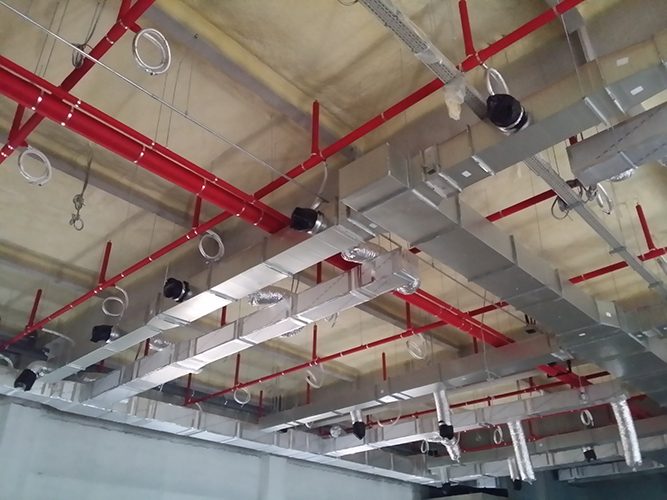Understanding Sprinkler Piping Arrangements
Tree, looped and gridded layouts can be connected to meet complex architectural features or to help with existing building expansions.

When designing an automatic fire sprinkler system, fire protection engineers have a few options for arranging the piping. This decision affects the sprinkler system in a few ways: it changes how the water flows from the water source to the sprinkler, how the system is calculated and the components used. However, there are limitations on when some of these arrangements can be used.
Understanding the benefits and drawbacks of each type of piping arrangement can help fire sprinkler designers, engineers and installers choose the best arrangement for their given scenario. This column reviews the three most common piping arrangements used and briefly discusses each.
Tree Sprinkler Systems
Sometimes called “dead-end systems,” tree systems were the first type of sprinkler system designed back when NFPA 13, Standard for the Installation of Sprinkler Systems, was first developed in the late 1800s. They are the most basic system of sprinkler pipe layout. In a tree system, the cross mains and the branch lines are tied together at a single point, which means only one path for the water to flow to an operating sprinkler.
They are often used in small systems or systems with good water pressure. Tree systems are the least efficient type of sprinkler system regarding friction loss in the piping, but the simplest to install.
The hydraulic calculations associated with tree systems are the most basic and can be done by hand. Since there is less piping, the installation of this system might cost less than other piping arrangements, but since the water inside the system only has one path to the sprinkler, it requires greater flow and pressure.
Another consideration is that if you are designing the system using the pipe-schedule method, the layout must be a tree-type layout, which is uncommon.

Looped Sprinkler System
NFPA 13 defines a looped sprinkler system as a “sprinkler system in which multiple cross mains are tied together to provide more than one path for water to flow to an operating sprinkler and branch lines are not tied together.”
In other words, the cross main pipe makes a loop, and the branch lines extend away from the loop. The big difference between a looped and gridded system is that in a looped system, the branch lines lead to a dead end, while in a gridded system, the branch lines are connected to the cross main on both ends. This means that for a looped system, the water has two paths to travel until it hits the branch line; then, it only has one path leading to an activated sprinkler.
A looped sprinkler system possesses better hydraulic characteristics than a tree system. While looped systems perform better than tree systems, their hydraulic characteristics are not as good as those of a gridded system. The hydraulic calculations associated with a looped system are not as complicated as those for a gridded system but more complicated than those for a tree.
Additionally, looped systems do not have the same limitations and design considerations as gridded systems.
Gridded Sprinkler System
According to NFPA 13, a gridded sprinkler system is one in which “parallel cross mains are connected by multiple branch lines, causing an operating sprinkler to receive water from both ends of its branch line while other branch lines help transfer water between cross mains.”
Gridded sprinkler systems are designed to provide multiple flow paths to the sprinklers on branch lines. This multiple-path design reduces the potential for pressure loss through the system piping compared with other system configurations. Due to the complex nature of the hydraulic calculations involved, computer hydraulic programs are almost always necessary to evaluate the piping grid and determine the pressure requirements of gridded systems.
Although the gridded system possesses advantageous hydraulic characteristics, certain limitations and design conditions are associated with its use. For example, gridded systems are not permitted for dry pipe systems and double interlock preaction systems because excessive air can remain trapped in the system piping, significantly delaying water from reaching the operating sprinklers.
A single interlock or noninterlock preaction system is not subject to this requirement.
As part of the plans and calculations, gridded system designs must also include verification that the hydraulically most demanding combination of sprinklers was selected. These calculations are iterative and require a computer to solve.
Learn More
Many systems today can be a combination of tree, loop and gridded configurations connected to meet complex architectural features or to help with existing building expansions. Whether you’re using a tree, loop or gridded system, the installation requirements for any sprinkler system can be found in NFPA 13, Standard for the Installation of Sprinkler Systems.
If you’re looking to learn more about sprinkler piping configurations and NFPA 13 sprinkler system design, I highly recommend checking out our online training offerings:
- NFPA 13, Standard for the Installation of Sprinkler Systems (2022) Online Training Series (https://bit.ly/49i9YUF);
- Certified Water-Based Systems Professional (CWBSP) Online Learning Path (https://bit.ly/3HEsACs);
- Water-Based Systems Layout and Design Online Training (https://bit.ly/49bEUWh).
Brian O’Connor is a senior engineer at the National Fire Protection Association.
[This article originally ran as a National Fire Protection Association technical blog; reprinted with light editing.]




